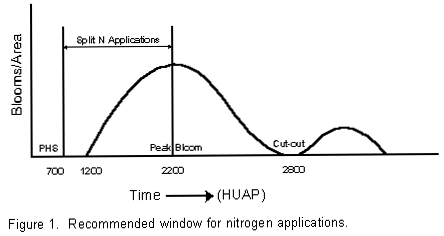Economic pressures and other constraints continue to force producers to find the most efficient and profitable means of production. The traditional approach to cotton production in many areas of the desert Southwest (Arizona, California, and northern Mexico) has been to fully utilize the long growing season. A full season management strategy commonly involves the completion of the first or primary fruiting cycle, moving the crop through cut-out, and then developing a top-crop (or second fruiting cycle) as described in Figure 1. A reduced season approach essentially involves the management and complete maturation of the crop through the primary fruiting cycle only.
A number of incentives serve to encourage the development of crop production strategies that can cut production costs in an attempt to improve profitability. Some of these incentives include increasing water costs, limited water availability (for some irrigation districts in some years), nutritional requirements of the crop that must be sustained the full length of the season, late-season insect problems (e.g. pink bollworm and whitefly), and increasing concerns over maintaining high quality lint. Interests in reducing production costs are accentuated by the fact that current cotton market prices (and future projections) are rather low.
Cultural control of insect pests is an important component in a cotton production system and entomologists have often called for alterations in cotton planting and irrigation termination timing to help control pests such as pink bollworm and whitefly. Substantial evidence has been developed to reinforce these recommendations. For this reason it is necessary to identify optimum planting windows and irrigation termination timing that takes into account agronomic, entomological, and economic factors.
The optimum period for cotton production in the low deserts of Arizona extends from the later part of March to about mid-July. This will always be based to some extent on the weather conditions in the spring and the occurrence of the monsoon season, which can typically be expected to begin around mid-July. From research conducted in Arizona, we have found that early planting (<700 HU accumulated after 1 Jan.) commonly results in the highest yield potential for full-season varieties of Upland and Pima cotton. Soil and weather conditions in the desert Southwest should be favorable by the time 300 HU have accumulated after 1 Jan, in order to consider initial plantings. However, soil temperature (> 55 ° F) and weather forecast information must always be incorporated into any planting strategy. For example in central Arizona, later March and early April represent optimum planting windows. By late April and May the plant should establish a strong root system, initiate fruiting in a timely fashion (nodes 5 to 7), retain early squares, and have strong vigor.
Early June to mid-July represents a critical period for cotton production in Arizona. Plants need a strong fruit load and high vigor at this stage of the season in order to realize a high yield potential. A goal should be to reach peak bloom by early July for low elevation areas of Arizona and progress significantly past peak bloom before the occurrence of the monsoon weather. This translates to an intense level of management for the cotton crop from planting to peak bloom. Optimum water and nutrient management to minimize stress throughout this critical period of growth is very important. For example, optimal N management involves applications of fertilizer N between pinhead square (PHS) formation and peak bloom (Figure 1).
The progression of the crop through the completion of the first fruiting cycle (cut-out) can be used to determine when irrigation should be terminated. Irrigation termination prior to the development of late-season insect pests, or to reduce production inputs, can be an important objective to consider in an effort to improve efficiencies and profits. Field research in many cotton producing areas of Arizona has shown that the combination of early planting and irrigation termination to complete the development of the first fruiting cycle can maintain lint yield potentials for full, mid, or short season varieties of Upland and Pima cotton. This approach can help avoid additional production costs with late-season inputs.
The economics dictating the most efficient or profitable scheme of production will be unique for each farm (or field). However, due to the basic nature of the cotton plant, and based on recent research conducted in Arizona, a reduced season approach to production as previously described can offer a reasonable strategy to reducing costs of production and increasing production efficiencies. Therefore, management in the early stages of the season can be very important in realizing the full benefit of crop production potentials. The following list enumerates some basic points that are important to consider in the development of an efficient and profitable cotton production strategy (with good yields and quality).
- early/optimum planting
- good insect pest scouting and control
- proper variety selection
- monitoring crop development
- manage for early fruiting
- proper timing of irrigation terminations
- protection of early fruit
- effective defoliation
- manage for high fruit retention
- timely harvest
Issued in furtherance of Cooperative Extension work, acts of May 8 and June 30, 1914, in cooperation with the U.S. Department of Agriculture, James A. Christenson, Director Cooperative Extension, College of Agriculture and Life Sciences, The University of Arizona.
The University of Arizona is an equal opportunity, affirmative action institution. The University does not discriminate on the basis of race, color, religion, sex, national origin, age, disability, veteran status, or sexual orientation in its programs and activities.
Any products, services, or organizations that are
mentioned, shown, or indirectly implied in this web document do not imply
endorsement by The University of Arizona.
Information provided by Jeffrey C. Silvertooth, silver@ag.arizona.edu
Extension Agronomist - Cotton, College of Agriculture, The University of Arizona.
Material written 15 March 1999.
Home | Cotton | Advisories
document located at: http://cals.arizona.edu/crops/cotton/comments/mar1999cc.html
Copyright © 2001 University of Arizona,
College of Agriculture and Life Sciences
Webmaster: Al Fournier (acis@ag.arizona.edu)
